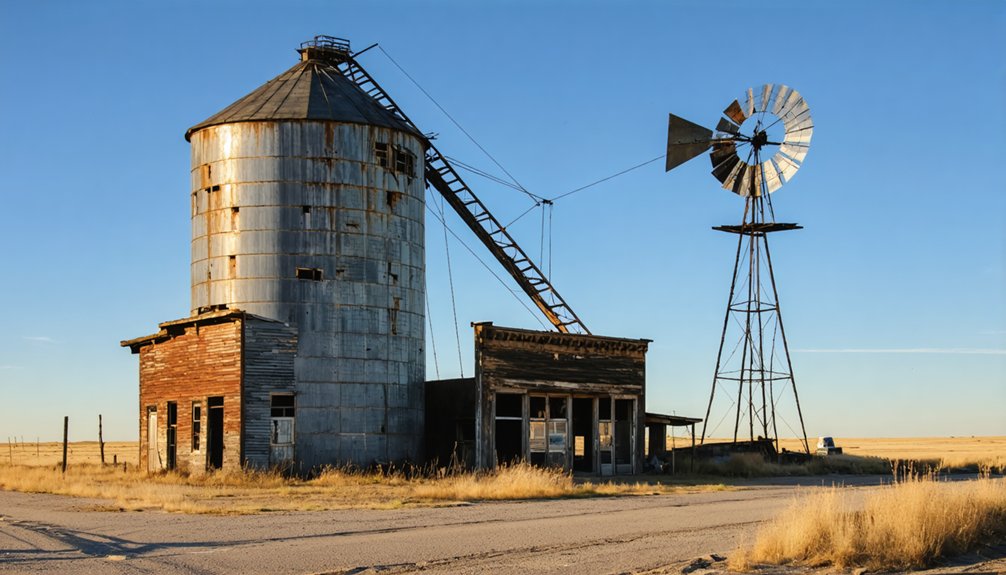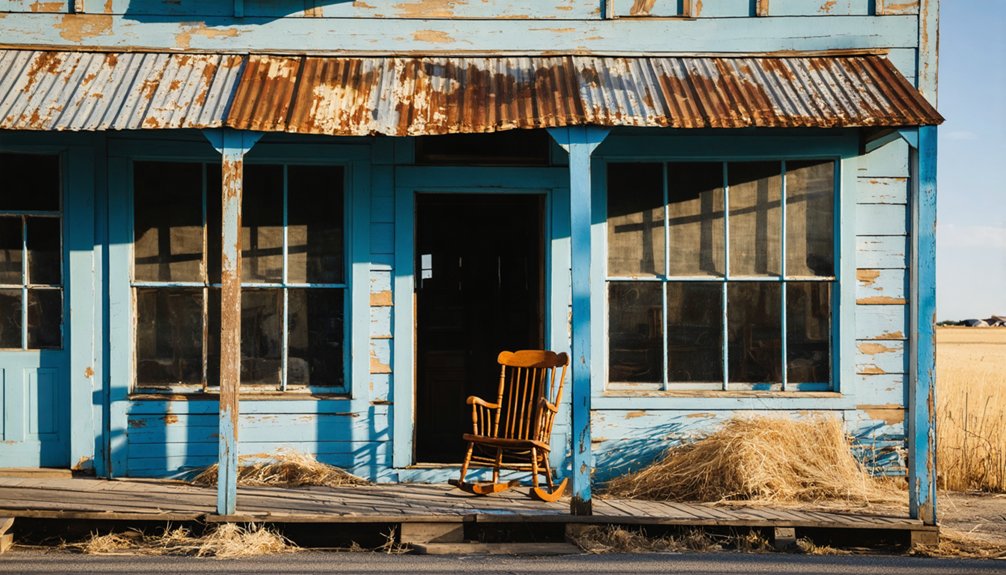You’ll find Morganfield in southeastern South Dakota’s Union County, near the Iowa and Nebraska borders. This former frontier settlement emerged in the late 1800s as a thriving railroad hub along the Chicago, Burlington & Quincy Railroad, supported by agriculture and essential services like hotels and grain elevators. Today, you can explore scattered foundations, converted railroad trails, and weathered structures that tell the story of this once-bustling community‘s rise and eventual abandonment. The site’s remote location holds more secrets waiting to be discovered.
Key Takeaways
- Morganfield was a late 19th-century South Dakota frontier town that thrived on agriculture and railroad connections before becoming abandoned.
- The town featured two hotels, grain elevators, and farm implement dealerships serving local farmers and railroad workers.
- Economic decline began when transportation shifts reduced railroad services, leading to job losses and population exodus.
- Today, scattered foundations, building footings, and weathered structures outline the original town’s layout on private land.
- Access to ghost town remnants is possible via unpaved roads from I-90, though permission is required to explore private property.
The Rise and Fall of a Frontier Settlement
When frontier expansion swept across South Dakota in the late 19th century, Morganfield emerged as one of many small settlements hoping to capitalize on the region’s economic potential.
You’ll find its story mirrors the frontier challenges faced by countless plains communities – a tale of determined settlers building lives around railroad connections, agriculture, and small-scale lumber operations.
The town’s initial promise drew hardy pioneers who established essential services: a post office, general stores, and likely a train station to support the growing community. Similar to Awanka’s early years, the settlement boasted two busy hotels to accommodate travelers and workers.
Determined settlers transformed raw prairie into a functional town, adding vital services that formed the backbone of frontier life.
Their community resilience shone through as they built churches, schools, and businesses. Today, like many ghost town sites, the area has largely reverted to empty fields and pasture land.
But like many frontier settlements, Morganfield couldn’t sustain its early momentum.
When the railroad’s influence waned and environmental hardships struck, the town’s population dwindled until it joined the ranks of South Dakota’s ghost towns.
Geographic Location and Natural Features
Located in southeastern South Dakota’s Union County, Morganfield stood amid the fertile plains where Iowa and Nebraska’s borders meet.
You’ll find the land here characterized by gently rolling terrain, shaped by ancient glacial activity that left subtle ridges and terraces across the landscape.
The town’s topographical features included flat to undulating prairie, with scattered small streams providing natural drainage.
While there weren’t any major lakes directly at the site, the hydrological characteristics typical of the region included seasonal waterways and groundwater sources that supported farming and livestock.
The climate brought warm summers and harsh winters, with enough precipitation to sustain tallgrass prairie ecosystems.
Like many ghost towns in the area, Morganfield likely developed near transportation routes, though its exact coordinates remain uncertain in historical records.
The arrival of the Transcontinental Railroad in the 1870s spurred development of numerous settlements across the Plains region.
Similar to the Scenic Ghost Town in western South Dakota, the area retained traces of its frontier past while adapting to modern times.
Economic Foundations and Industry
Unlike many Black Hills ghost towns that thrived on mining, Morganfield’s economic foundation centered on agriculture and railroad connections in Union County.
You’d find grain elevators and farm implement dealerships dotting the landscape, rather than mining techniques like cyanide vats or hard rock mining operations common in other ghost towns. While places like Moonshine Gulch Saloon brought entertainment to mining communities, Morganfield focused purely on agricultural trade.
The town’s prosperity hinged on its strategic position along crucial transportation routes, particularly the railroad that connected it to regional markets.
Local businesses, including general stores, hotels, and blacksmith shops, supported the farming community and railroad workers. The area’s rustic backdrop provided a striking contrast against the abandoned structures.
However, when transportation patterns shifted and newer routes bypassed Morganfield, the town’s economy couldn’t sustain itself.
Without the diverse industrial base found in larger communities, Morganfield gradually lost its economic vitality and residents.
Life in Early Morganfield
In early Morganfield, you’d find settlers working tirelessly at farming, ranching, and establishing homesteads while facing the challenges of rattlesnake encounters and harsh weather conditions.
The nearest supplies and services required long wagon journeys over rough terrain to reach small clusters of buildings housing groceries, post offices, and livery stables. The James River dam completed in 1882 helped improve transportation and access to goods for many rural settlers. Many settlers like Julia Culver made these journeys with covered wagons carrying their essential supplies and camping gear.
Despite the isolation, community gatherings brought settlers together from miles around, traveling by wagon or horseback to participate in social events that strengthened their communal bonds.
Daily Work and Trade
Life in early Morganfield revolved around a predictable rhythm of agricultural labor and local commerce. You’d find yourself working alongside family members from sunrise to sunset, tending to crops and livestock through each changing season.
The town’s economic backbone relied on seasonal labor during planting and harvest times, while local craftsmen kept equipment running and supplies flowing. Like many other towns before truck transport became common, Morganfield’s economy was closely tied to the railroad.
You could’ve participated in the town’s active barter economy, trading eggs or milk at the general store for manufactured goods, or exchanging services with neighbors.
The railroad’s presence meant you weren’t entirely cut off from broader markets – you’d sell your grain and livestock to distant buyers, while traveling salesmen brought new products and connections to the outside world.
Success depended heavily on weather conditions and market prices, making each year’s outcome uncertain.
Social Events and Recreation
Despite their physical isolation, Morganfield’s residents forged strong social bonds through regular community gatherings and simple entertainments. You’d find neighbors coming together for church services, seasonal festivals, and agricultural shows, where they’d share stories and celebrate rural traditions.
Children played outdoors while adults socialized at barn raisings and harvest events.
Similar to Okaton’s old wooden church, residents would gather frequently for spiritual and community functions.
During evenings and weekends, you could join in box socials, dances, and music nights at the local church or school. Recreation centered around practical activities like hunting, fishing, and berry picking.
When traveling entertainers or salesmen passed through, they’d bring welcome diversions to daily life. The arrival of mail delivery brought excitement, connecting you to the outside world through letters, newspapers, and catalogs.
The Path to Abandonment

While Morganfield once thrived as a bustling railroad hub along the Chicago, Burlington & Quincy Railroad, its path to abandonment began with the town’s dangerous reliance on a single economic lifeline.
You’ll find that transportation shifts hit Morganfield particularly hard when rail services diminished and highways bypassed the community, severing vital commercial connections that had sustained local businesses.
The town’s population dynamics followed a familiar pattern of decline – as job opportunities in lumber, coal, and cattle shipping dried up, residents began moving away.
Without its railroad backbone, Morganfield couldn’t maintain basic infrastructure. Buildings fell into disrepair, roofs collapsed, and key facilities shut down.
The few remaining inhabitants eventually joined the exodus to larger towns where services and employment remained accessible.
Present-Day Remnants and Legacy
While you won’t find intact buildings at Morganfield today, you’ll discover scattered foundations and building footings that outline the town’s original layout.
You can explore the area via converted railroad grades that now serve as hiking and biking trails, though most of the site sits on private land requiring permission to visit.
The town’s legacy lives on through its grave markers and cemeteries, which stand as some of the few permanent reminders of this once-bustling Black Hills community.
Standing Structures Today
Several standing structures remain in present-day Morganfield, South Dakota, offering glimpses into its pioneer past.
You’ll find weathered wood-frame houses and commercial buildings scattered across the prairie landscape, most in various states of disrepair from decades of abandonment. While some structures receive occasional maintenance from family descendants, the majority stand as silent witnesses to the town’s former importance.
- Original residential homes showcase typical Black Hills settlement architecture
- Foundation stones and chimneys mark locations of collapsed buildings
- Agricultural outbuildings like barns and storage sheds dot the landscape
- Former commercial structures highlight the town’s historical significance
These remaining buildings, now mostly on private ranch lands, serve as significant examples of early South Dakota pioneer construction and settlement patterns.
Grave Sites and Markers
Limited documentation exists regarding grave sites and markers in Morganfield’s historic boundaries. You won’t find any confirmed grave markers or historical burial grounds within the area, as no official discoveries have been documented.
The remote location and lack of preservation efforts have made it challenging to conduct thorough investigations of potential burial sites.
While grave sites often provide valuable insights into a settlement’s historical significance, Morganfield’s case remains largely unexplored. Future research expeditions might uncover previously unknown locations, but currently, you’ll need to rely on broader regional history to understand the town’s context.
The absence of documented grave sites reflects the broader challenge of piecing together Morganfield’s past, as minimal records exist to guide researchers and historians.
Modern Trail Access
Today’s visitors can access Morganfield’s ghost town remnants through a network of unpaved dirt roads and gravel paths that branch off from I-90.
Trail maintenance guarantees year-round accessibility, though winter conditions can make passages challenging. You’ll find self-guided exploration opportunities perfect for experiencing South Dakota’s rugged history firsthand.
- Multiple all-terrain vehicle routes lead to foundation ruins and scattered mining equipment
- Former railway corridors now serve as grassy hiking paths with interpretive markers
- Mountain biking trails wind through partially wooded areas, revealing historic building sites
- Educational hiking routes connect to other Black Hills ghost towns via marked pathways
Your visitor experience might include encountering weathered mill remnants, water tanks, and other industrial artifacts while maneuvering through these historic trails.
Local historical societies work to preserve these cultural sites while maintaining public access.
Frequently Asked Questions
Are There Any Known Photographs of Morganfield During Its Active Years?
You won’t find confirmed historic photographs in town archives, though there’s a reference to “Morganfield Pictures” in Early Dakota Days that hasn’t been verified or made publicly accessible.
What Wildlife Species Now Inhabit the Abandoned Town Site?
Where nature abhors a vacuum, you’ll find abundant wildlife sightings, from white-tailed deer and coyotes to ravens nesting in old buildings, creating remarkable species diversity throughout the abandoned structures.
Were Any Famous Outlaws or Notable Figures Associated With Morganfield?
You won’t find any famous outlaws or notable figures connected to Morganfield in historical records. Unlike nearby Deadwood, this small railroad settlement lacks documented ties to Wild West personalities or legendary characters.
Does Anyone Still Own Property Titles Within the Former Town Limits?
You’ll find property ownership details unclear, as there’s no public confirmation of active titles. While some ghost towns retain private ownership, Morganfield’s specific title history requires county courthouse research.
Have Any Paranormal Activities or Ghost Stories Been Reported at Morganfield?
Where there’s smoke, there’s fire, but you won’t find documented ghost sightings or haunted locations here. Though nearby ghost towns have paranormal tales, there’s no verified supernatural activity at this site.
References
- https://en.wikipedia.org/wiki/List_of_ghost_towns_in_South_Dakota
- https://www.sdpb.org/rural-life-and-history/2023-08-21/some-black-hills-ghost-towns-and-their-origins
- https://www.youtube.com/watch?v=_0WNYsFLSLA
- https://www.youtube.com/watch?v=Glucs_Rq8Xs
- https://www.sdhspress.com/journal/south-dakota-history-2-2/some-black-hills-ghost-towns-and-their-origins/vol-02-no-2-some-black-hills-ghost-towns-and-their-origins.pdf
- https://www.powderhouselodge.com/black-hills-attractions/fun-attractions/ghost-towns-of-western-south-dakota/
- https://aberdeenmag.com/2019/01/the-ghost-towns-of-brown-county/
- https://www.familysearch.org/en/wiki/Union_County
- https://icatchshadows.com/okaton-and-cottonwood-a-photographic-visit-to-two-south-dakota-ghost-towns/
- https://www.onlyinyourstate.com/state-pride/north-dakota/lost-town-nd



